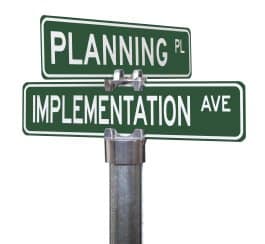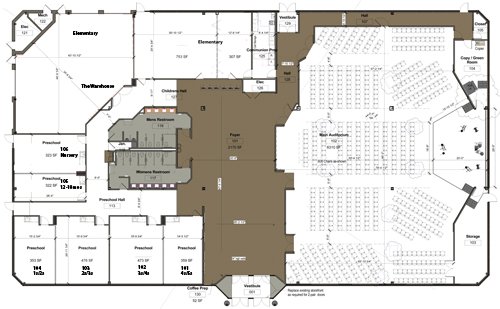Our church moved into a new building a while back, and one of the things I had to plan for was the children's ministry space and how much we would need. In this post, I'll share how I approached it in terms of planning for space, planning the budget, and implementing those plans.
How Much Children's Ministry Space Do I Need?

That's an easy one to answer, right? As much as I can possibly get!
But, most of us have to make a case for how much space is needed for children's ministry. There are so many factors that go into determining that, and therefore a one-size-fits-all calculation doesn't really exist. But, here are some helpful questions to ask when figuring out how much space you'll need for children's ministry.
- On average, how many children attend versus how many people are in seats in the main service? Most churches have about 25% of their attendance from children (birth-5th grade). A church of 1000 would be made up of 250 kids (25%) and 750 adults/students. That's a 1:3 ratio, meaning 1 kid for every 3 adults/students. Leave room for that percentage to grow if that has been the trend and/or if you're a new church plant with mostly younger attenders.
- How many seats are in the service? This is usually the driving number for everything else in the building. If you have 900 seats in the auditorium, you can estimate how many children will attend using the ratio in the previous question. If children make up 25% of your attendance, then your ratio is 1:30 and 1/3 of 900 = 300. In this case, one service could seat 900 adults/students and should be able to fit the 300 children we'd expect to come with them.
- What does balance look like? – In general, I would not plan for balance since it rarely happens, especially if you ever plan on having more than 2 services. Plan your children's ministry space to accommodate the lack of balance. For instance, what if in 2 services they were balanced in the auditorium, but in preschool, 66% came to the early service? That is very common.
- Do you follow the 80% rule? The 80% rule says that when a room is 80% full, it feels completely full. That's because seats are few and far between and often times you can't find 2 or more together. If you follow that rule and would rarely push past 80%, you can adjust your expectations accordingly. Also, rooms feel different. Our new space feels full at 65%.
- How is your children's attendance made up across age groups? Is it 50% in preschool and 50% in elementary? It's good to look at your history and get an idea of how that balances out so you can plan accordingly when dividing up space. Keep in mind those shift over time as well, especially if the average age goes up.
- What is your state's minimum requirement for square feet/child for daycare facilities? Ours is 35sqft, and we've found that to be a good minimum for us. Sometimes you'll see 35sqft for preschoolers and 25 or 30sqft for elementary. We've made them all work.
- What extra rooms do you want/need? A resource room. A room for volunteers to meet in. Maybe even a “fun room” for children of volunteers who are there for 2 services, and can hang out in that room with a different volunteer team during one of them. A lot of children's ministry space isn't your typical rooms where ministry happens. It's the space that supports it.
We look at all of those things when planning for a new space. I hope those are helpful to you if you are looking to move or add on to your existing environment.
What else have you found to be helpful?
Planning and Budgeting for Children's Ministry Space

Planning and budgeting for a move into a new space can be very difficult. This post is about what's in the environment once the walls are up, not the construction part. That's a whole separate challenge. Once you know how much space you'll have, where it is, and an idea of what it will be like, you're ready to create the environment. Here are some tips to help guide you along that process.
- Take a full inventory of what you have. It's easy to remember the obvious things you already have like how many projectors or how many circle carpets. Be sure to inventory everything you have that might be useful in the new space. Some of it may be stored away.
- Brainstorm 3 separate lists for what you might want in each room. One list for technical items, one for functional items, and one for decor. Once you have your brainstormed ideas, filter down to what you really want and leave out the rest. But, be sure to keep in things you know you may not be able to get right away. The filter part is more about figuring out what doesn't fit, not what you can't afford.
- Prioritize each list by dividing them up into groups. Maybe it's 2 groups, needs and wants. Just recently we came up with 3 phases and divided the ideas into each phase.
 Create a budget. This is the most difficult part and people/organizations do it differently. Some like to budget from the bottom up, by pricing everything out in the lists and coming up with a number. I only do that if money is tight. Which, let's face it, it usually is. You can also budget from the top down by seeing the total available and allocating it accordingly.
Create a budget. This is the most difficult part and people/organizations do it differently. Some like to budget from the bottom up, by pricing everything out in the lists and coming up with a number. I only do that if money is tight. Which, let's face it, it usually is. You can also budget from the top down by seeing the total available and allocating it accordingly.- Build in the margin. Either way you prepare the budget, you need to account for unexpected expenses. I would add in a minimum of 10% extra, but ideally 25%, to cover those expenses. We probably spent an extra 5% just in hardware (beyond what we planned) to install everything we needed.
- Talk through the plan with some different people. Sharing your plan (not necessarily budget) with key people can help you catch things you forgot. The small group leader might remember you need more resource bins and the large group leader may remember you need to replace a dead microphone.
- Decide what you can sell, and sell it. If you're upgrading in some areas or simply not using some things anymore, plan to sell them and recoup some of that money to put towards the new purchases. We had an awesome volunteer sell some of our stuff on eBay.
One of the most helpful things, in the beginning, is making sure everyone is on the same page about the quality of environments you are looking to create as well as the style and feel you're going for.
How do you plan and budget for a new environment?
Implementing Your Plan Effectively

 Now that you have dreamed about what it could look like, figured out what you can realistically pull off, and made decisions and purchases towards that end, it's time to prepare for the work you have to do to make it all come to fruition. Moving into a new children's ministry space is A LOT of work, and planning effectively in advance can save you from wasting tons of hours. Here are some tips we learned that might help you as you plan your part of the work.
Now that you have dreamed about what it could look like, figured out what you can realistically pull off, and made decisions and purchases towards that end, it's time to prepare for the work you have to do to make it all come to fruition. Moving into a new children's ministry space is A LOT of work, and planning effectively in advance can save you from wasting tons of hours. Here are some tips we learned that might help you as you plan your part of the work.
- Determine when you'll be able to start and what the facility will be like. In many cases, you won't be able to do anything until construction is completely wrapped up and all permits are in hand. In other cases, you may be able to work in the space prior to construction wrapping up. It's important for you to know in advance which one applies to you.
- List out the big milestones that must be completed in order for certain tasks to be done. For instance, paint must be done before you can mount things to walls and electric must be done before you can set up and test your audio/video/lighting system. Beyond that, you may want your stage done before setting up the rest of the room. Some example milestones related to construction could be electrical, paint, flooring, or permits. Milestones related to your schedule could be the stage, audio/video/lighting, storage, signage, or seating.
- Make a complete list of items to be done and group them by the milestone that must be finished before it can be started. Be sure the tasks are broken down to very specific items that could easily be delegated. Some things will need multiple tasks in order for that to be possible. Within those milestones, prioritize the most important items that MUST happen before you open in the new children's ministry space.
- Double-check to ensure you have all the supplies and resources you need to carry out each task. We could have spent more time figuring out how we would accomplish some things in advance, and purchasing the necessary supplies so we weren't doing that when the time crunch was on.
- Recruit people to help accomplish specific tasks during allotted times when they can work on it. As with most things in ministry, you never want to work on it alone. Ask people to help and give them as much as you can. If all of your time is used to direct people and solve problems, that's a good thing because there will be plenty of that to do.
We used a simple Google sheet to list out all our tasks and we referred to it often to make sure we were still on track. It was also helpful to remind us of tasks we could have easily forgotten along the way.
What tips would you give for working on a new space for children's ministry?
Need help planning your children's ministry space?
I'd love to help if I can. Simply fill out the contact form here to get the conversation started.







Great stuff. Excellent thoughts and research. Thank you Nick!
You’re welcome!
Looks great. Currently going through a KidMin facility build/upgrade process.